Related Research Articles

King Arthur, according to legends, was a king of Britain. He is a folk hero and a central figure in the medieval literary tradition known as the Matter of Britain.

Sir Gawain and the Green Knight is a late 14th-century chivalric romance in Middle English alliterative verse. The author is unknown; the title was given centuries later. It is one of the best-known Arthurian stories, with its plot combining two types of folk motifs: the beheading game and the exchange of winnings. Written in stanzas of alliterative verse, each of which ends in a rhyming bob and wheel, it draws on Welsh, Irish, and English stories, as well as the French chivalric tradition. It is an important example of a chivalric romance, which typically involves a hero who goes on a quest which tests his prowess. It remains popular in modern English renderings from J. R. R. Tolkien, Simon Armitage, and others, as well as through film and stage adaptations.

Gawain, also known in many other forms and spellings, is a character in Arthurian legend, in which he is King Arthur's nephew and one of the premier Knights of the Round Table. The prototype of Gawain is mentioned under the name Gwalchmei in the earliest Welsh sources. He has subsequently appeared in many Arthurian tales in Welsh, Latin, French, English, Scottish, Dutch, German, Spanish, and Italian, notably as the protagonist of the Middle English poem Sir Gawain and the Green Knight. Other works featuring Gawain as their central character include De Ortu Waluuanii, Diu Crône, Ywain and Gawain, Golagros and Gawane, Sir Gawain and the Carle of Carlisle, L'âtre périlleux, La Mule sans frein, La Vengeance Raguidel, Le Chevalier à l'épée, Le Livre d'Artus, The Awntyrs off Arthure, The Greene Knight, and The Weddynge of Syr Gawen and Dame Ragnell.
Patience is a Middle English alliterative poem written in the late 14th century. Its unknown author, designated the "Pearl Poet" or "Gawain-Poet", also appears, on the basis of dialect and stylistic evidence, to be the author of Sir Gawain and the Green Knight, Pearl, and Cleanness and may have composed St. Erkenwald. This is thought to be true because the techniques and vocabulary of regional dialect of the unknown author is that of Northwest Midlands, located between Shropshire and Lancashire.

The "Gawain Poet", or less commonly the "Pearl Poet", is the name given to the author of Sir Gawain and the Green Knight, an alliterative poem written in 14th-century Middle English. Its author appears also to have written the poems Pearl, Patience, and Cleanness; some scholars suggest the author may also have composed Saint Erkenwald. Save for the last, all these works are known from a single surviving manuscript, the British Library holding 'Cotton MS' Nero A.x. This body of work includes some of the most highly-regarded poetry written in Middle English.

Pearl is a late 14th-century Middle English poem that is considered one of the most important surviving Middle English works. With elements of medieval allegory and from the dream vision genre, the poem is written in a North-West Midlands variety of Middle English and is highly—though not consistently—alliterative; there is, among other stylistic features, a complex system of stanza-linking.
Cleanness is a Middle English alliterative poem written in the late 14th century. Its unknown author, designated the Pearl poet or Gawain poet, also appears, on the basis of dialect and stylistic evidence, to be the author of Sir Gawain and the Green Knight, Pearl, and Patience, and may have also composed St. Erkenwald.

The Green Knight is a heroic character of the Matter of Britain, originating in the 14th-century poem Sir Gawain and the Green Knight and the related medieval work The Greene Knight. His true name is revealed to be Bertilak de Hautdesert in Sir Gawain, while The Greene Knight names him "Bredbeddle". The Green Knight later features as one of Arthur's greatest champions in the fragmentary ballad King Arthur and King Cornwall, again with the name "Bredbeddle".
The Dialogue on Translation between a Lord and a Clerk, or Dialogus inter dominum et clericum, was written by John Trevisa. Along with the dedicatory Epistle, it forms the introduction to his 1387 translation of the Polychronicon of Ranulf Higden, commissioned by Trevisa's patron, Lord Berkeley. Written in Middle English, it consists of a series of arguments made by the clerk on why books should not be translated from learned languages such as Latin, each one followed by a rebuttal from the lord. The clerk eventually agrees, and the exchange concludes with a prayer for guidance in the translation.
Jessie Laidlay Weston was an English independent scholar, medievalist and folklorist, working mainly on mediaeval Arthurian texts.
The term Middle English literature refers to the literature written in the form of the English language known as Middle English, from the late 12th century until the 1470s. During this time the Chancery Standard, a form of London-based English, became widespread and the printing press regularized the language. Between the 1470s and the middle of the following century there was a transition to early Modern English. In literary terms, the characteristics of the literary works written did not change radically until the effects of the Renaissance and Reformed Christianity became more apparent in the reign of King Henry VIII. There are three main categories of Middle English literature, religious, courtly love, and Arthurian, though much of Geoffrey Chaucer's work stands outside these. Among the many religious works are those in the Katherine Group and the writings of Julian of Norwich and Richard Rolle.

Perceval, the Story of the Grail is the unfinished fifth verse romance by Chrétien de Troyes, written by him in Old French in the late 12th century. Later authors added 54,000 more lines to the original 9,000 in what are known collectively as the Four Continuations, as well as other related texts. Perceval is the earliest recorded account of what was to become the Quest for the Holy Grail but describes only a golden grail in the central scene, does not call it "holy" and treats a lance, appearing at the same time, as equally significant. Besides the eponymous tale of the grail and the young knight Perceval, the poem and its continuations also tell of the adventures of Gawain and some other knights of King Arthur.

The Wedding of Sir Gawain and Dame Ragnelle is a 15th-century English poem, one of several versions of the "loathly lady" story popular during the Middle Ages. An earlier version of the story appears as "The Wyfe of Bayths Tale" in Geoffrey Chaucer's The Canterbury Tales, and the later ballad "The Marriage of Sir Gawain" is essentially a retelling, though its relationship to the medieval poem is uncertain. The author's name is not known, but similarities to Le Morte d'Arthur have led to the suggestion that the poem may have been written by Sir Thomas Malory.

Lady Bertilak are names given by some modern critics to a character in the medieval poem Sir Gawain and the Green Knight, though the poem itself only ever calls her "the lady". She is ordered by her husband, Sir Bertilak de Hautdesert, alias the Green Knight, to test Sir Gawain's purity.
Malcolm Andrew is an author, teacher and scholar who was previously Professor of English Language and Literature at Queen's University Belfast. He started teaching at Queen's in 1985, before which he had worked at the University of East Anglia. He retired in 2007. He also served as Head of School (1986–92), Dean of Humanities (1992–98), and Pro-Vice-Chancellor (1998–2002).
Marie Edith Borroff was an American poet, translator, and the Sterling Professor of English emerita at Yale University.
Sir Gawain and the Carle of Carlisle is a Middle English tail-rhyme romance of 660 lines, composed in about 1400. A similar story is told in a 17th-century minstrel piece found in the Percy Folio and known as The Carle of Carlisle. These are two of a number of early English poems that feature the Arthurian hero Sir Gawain, the nephew of King Arthur, in his English role as a knight of the Round Table renowned for his valour and, particularly, for his courtesy.

John Massey is one conjectured name of the Gawain Poet, author of Sir Gawain and the Green Knight and probably of several other 14th-century Middle English poems. Internal evidence from the text of the poems and marginalia of the manuscript suggests the name "John Massey" or similar; contemporary records of people of the name who might have been poets include one from the village of Cotton in Cheshire.
Thomas Hahn is an American professor of medieval literature and English who has taught since 1973 at the University of Rochester. After undergraduate studies at Fordham, he completed a Ph.D. at UCLA in 1974. He is especially known for his work on medieval European travel narratives, race in pre-modern Europe, and the modern reception of Robin Hood. He has advised over three dozen Ph.D. students during his fifty years at Rochester. Hahn's interest in medieval English literature, as well as its intersection with popular culture, is reflected both in his publications and in the conferences he has organized.

The Pearl Manuscript, also known as the Gawain manuscript, is an illuminated manuscript produced somewhere in northern England in the late 14th century or the beginning of the 15th century. It is one of the best-known Middle English manuscripts, the only one containing alliterative verse solely, and the oldest surviving English manuscript to have full-page illustrations. It contains the only surviving copies of four of the masterpieces of medieval English literature: Sir Gawain and the Green Knight, Pearl, Cleanness, and Patience. It has been described as "one of the greatest manuscript treasures for medieval literature", and "the most famous of all romance manuscripts".
References
- ↑ "Sir Israel Gollancz Memorial Lectures". The British Academy. text
- 1 2 Powell, Susan; Smith, Jeremy J., eds. (2000). New Perspectives on Middle English Texts: A Festschrift for R.A. Waldron. Woodbridge, Suffolk; Rochester, N.Y.: D.S. Brewer. p. ix. ISBN 978-0-85991-590-8. OCLC 43757539. Festschrift is a loan word from German: Festschriften are usually produced for anniversaries or retirements, and often include a "tabula gratulatoria" and a bibliography of all the academic work of the recipient.
- ↑ Waldron, Ronald Alan, ed. (1970). Sir Gawain and the Green Knight. Evanston, Illinois: Northwestern University Press. p. 139. ISBN 978-0-8101-0328-3. OCLC 135649.
- ↑ Andrew, Malcolm; Waldron, Ronald Alan (1978). The Poems of the Pearl Manuscript: Pearl, Cleanness, Patience, Sir Gawain and the Green Knight . Berkeley: University of California Press. pp. 373. ISBN 978-0-85989-726-6. OCLC 5241542.
- ↑ Kennedy, Edward Donald; Waldron, Ronald Alan; Wittig, Joseph S. (1988). Medieval English Studies Presented to George Kane. Wolfeboro, N.H.: D. S. Brewer. pp. 327. ISBN 978-0-85991-262-4. OCLC 16833713.
- ↑ Finch, Casey; Waldron, Ronald Alan; Andrew, Malcolm; Peterson, Clifford J. (1993). The Complete Works of the Pearl Poet. Berkeley: University of California Press. p. 488. ISBN 978-0-520-07871-0. OCLC 25409834.
- ↑ Waldron, Ronald Alan (2001), "Doublets in the Translation Techniques of John Trevisa", Lexis and Texts in Early English: Studies Presented to Jane Roberts, Amsterdam; Atlanta: Rodopi: [, clarification needed ], , ISBN 978-90-420-1001-7, OCLC 46827633